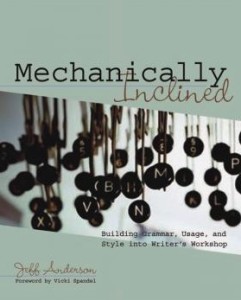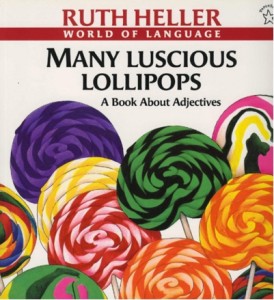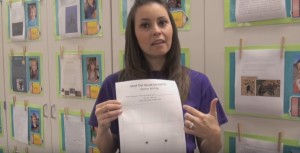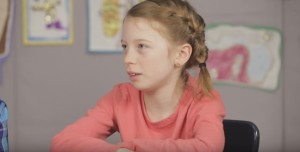I hate writing. I enjoy having written.
The act of writing involves balancing a complex set of cognitive tasks. Even experienced authors, novelists and journalists can struggle mightily with successfully juggling idea generation and information gathering/organization, the word choices and rhythm that goes into bringing ideas to life on the page. And then there’s the problem of mechanics—where to put commas, paragraph breaks, punctuation—and don’t forget grammar, the rules that govern the structure of sentences, clauses and phrases.
Taxing though it may be, (and trust us, writing is never easy at any level) writing is a key facet of literacy and a crucial skill for children of all ages.
Less than one-third of U.S. public school students in 8th and 12th grades performed at the ‘proficient’ level in writing on the 2007 National Assessment of Educational Progress Writing test.
Just like reading instruction, the approach to teaching writing in American schools has changed over time. For years, children were expected to just ‘pick up’ writing on their own, given texts to read and then write about, in the hopes that simply through exposure to good works, students could generate and grow in their own writing.
And while exposing children to different types of literature at various stages is an excellent supplemental facet of education, like reading, many teachers and researchers today believe that writing must be taught in a more direct manner.
Also like reading, children who feel they are not good at writing are apt to shy away from it, feeling as though they will never overcome their difficulties in stringing words together.
In 2002, the National College Board—a non-profit organization with 4,300 member schools and colleges—planned to roll out a new written portion of their college entrance exam, the SAT, by 2005. But along with those plans, the Board recognized its concerns and those of educators across the U.S. that student writing skills were not up to the standards increasingly required of a highly literate, increasingly internet-wired society.
To help identify the gaps in instruction and to help educators and students better prepare for the new written portions of the SAT in 2005, the College Board established the National Commission on Writing. That Commission created a 2003 report titled, “The Neglected ‘R’: The Need for a Writing Revolution.”
To read the full text of “The Neglected ‘R'”, click here: http://www.collegeboard.com/prod_downloads/writingcom/neglectedr.pdf
The report posited that of the traditional ‘3 R’s’—reading, writing and arithmetic—the second one, writing and direct instruction in writing skills had gotten short shrift in classrooms throughout the country.
Perhaps as a result of the lack of classroom time spent on teaching writing, many American students do not test as strong writers. Less than one-third of U.S. public school students in 8th and 12th grades performed at the ‘proficient’ level in writing on the 2007 National Assessment of Educational Progress Writing test.
The good news is: those numbers are up from previous years—with particular gains seen in urban schools and among male and ESL students—but it’s clear for many researchers and educators that writing instruction needs to improve if children are to perform at a level required in college and in the global workplace.
To read the full NAEP 2007 report on writing, click here: http://nces.ed.gov/nationsreportcard/pdf/main2007/2008468.pdf
For more than thirty years, University of Arizona professor Steve Graham has studied how students learn to write, how educators can best provide instruction for writing and the ways in which writing can be used to support and reinforce reading and overall literacy.
In June 2012, Graham and his team published a guide for the U.S. Department of Education’s Institute of Education Services (IES) with recommendations on how to best improve children’s writing skills, based on years of research.
“Teaching Elementary School Students to be Effective Writers,” identifies 4 key recommendations for educators.
To read Dr. Graham’s IES guide on writing, click here: http://ies.ed.gov/ncee/wwc/pdf/practice_guides/writing_pg_062612.pdf
The Four key recommendations are:
1. Provide daily time for students to write
Graham and his team acknowledge that more research needs to be conducted into how much time is needed to instruct students in writing to have those lessons be most effective, but they confirm: students across the board could benefit from more time in the classroom writing.
The panel recommends that students in Kindergarten spend at least 30 minutes a day on writing and developing writing skills. They recommend that starting in First Grade, students should spend 1 hour per day on writing.
2. Teach students the writing process for a variety of purposes
From persuasive essays to passages of fiction to newspaper articles, students should be introduced to different types of writing.
These various types of writing also call for different types of strategies to create the final written product. Writing a well-informed piece of journalism requires a great deal of up-front research versus a personal essay describing one’s own experience. Both require a good deal of backend revision and editing and both can be challenging to write. But walking students though the differences in each type of writing and the process in creating those works can help them to understand the structural mechanics and workflow involved in producing different types of writing.
Graham and his team outline several steps of the process, including: planning, drafting, sharing, evaluating and editing. These steps should be demonstrated by the instructor first, so that students have a model to emulate. Slowly, they recommend, the full responsibility of each step should be shifted onto the student.
“Writing today is not a frill for the few, but an essential skill for the many.”
—“The Neglected ‘R,'” 2003
3. Teach students to become fluent with handwriting, spelling, sentence construction, typing and word processing
The more students have mastery of the tools of writing—from handwriting to spelling and correct grammar, onward to typing and using word processing software—the more they can concentrate directly on the quality of their writing.
For students in Kindergarten, this means starting with learning how to hold a pencil and creating letters fluidly. Children at this level should also begin to develop an understanding of basic sentence construction. Teachers can support this by showing students how to use their verbal skills to create written sentences.
The report calls for children to be introduced to basic keyboarding skills in First Grade. By Fourth Grade, students are tested on their writing abilities while using a word processor, so it’s crucial that children get adequate time in the early grades to develop effective keyboarding skills and knowledge of word processing software.
4. Create an engaged community of writers
On page 34 of the guide, Graham and his colleagues write, “Students need both the skill and the will to develop as writers.” Writing, like any craft, must be practiced seriously and often to even attempt anything close to mastery.
To help students become passionate about writing, Graham and his team suggest having students write about things that interest them as a gateway to developing and honing their skills. Collaboration and spirited give-and-take feedback is also a key component of creating a supportive, fun writing environment.
Note that many of these recommendations align closely with the Common Core’s Language Arts Standards. For a listing of standards by grade, click here: http://www.corestandards.org/ELA-Literacy/W/K/
*****
We’ve assembled some additional tips to help parents and educators jumpstart their children’s writing at different stages.
Kindergarten
Children at the Kindergarten level may, on their own, incorporate ‘environmental print’ into their drawings of everyday scenes—like stop and traffic signs, business logos and more. Closely watching for these early attempts at mastering the printed word can provide opportunities to expand and deepen a student’s knowledge.
Dictation can also be a way for learners to expand their knowledge as they watch while words are transformed into visual objects.
Introducing children to word games like Scrabble, Boggle and other word finder puzzles can be a great way to reinforce spelling and to expand on vocabularies.
First Grade
By this stage, students can start working with short writing prompts. Get them writing about things they are familiar with: their pet, their brothers and sisters, their favorite foods. Prompts are a great way to have students construct short sentences and its an opportunity to work on fine motor skills in holding a pencil, handwriting and sentence construction and punctuation.
Per the recommendations of Dr. Graham and the IES 2012 guide to writing, first graders should spend time on learning how to correctly keyboard. There are a number of apps for the iPhone and iPad, as well as web sites that feature typing exercises that are age appropriate. Check out Keyboard Zoo from ABCYA.com: http://www.abcya.com/keyboarding_practice.htm
Second Grade
In the lower grades, students should be introduced to basic opinion writing to help prepare them for the Common Core standards of persuasive writing that are introduced in third grade.
By Second Grade, many students will have opinions about a lot of things—harnessing their natural interests is a great way to get going.
Check out this short video from Second Grade teacher Sandy Patterson, from Lindo Park School near San Diego, CA: https://www.youtube.com/watch?v=Icz4BrycFpo
Sandy selected the writing prompt, “Which animal should we choose as a classroom pet?” The children were then asked to research a selection of possible pets, including a hamster or fish. And then create an opinion piece about their selection and to backup their choice with research on each animal.
Third Grade
Many schools begin teaching students to write in longhand or cursive in Third Grade. While students are working on this skill, they’re also asked to expand their vocabularies and start learning more about the processes involved in writing—planning, drafting, sharing, revising and editing.
Helping students recognize the hallmarks of solid primary sources—original documents, books, newspaper articles—is a good first step at helping to develop critical thinking skills.
The Library of Congress provides some excellent tips and activities for educators: http://www.loc.gov/teachers/usingprimarysources/
Fourth Grade
In Fourth Grade, students are tested on their writing abilities. Writing assignments should allow for enough time to gather facts and resources, develop and write arguments, characters and ideas and then time to refine, revise and share these written pieces. ‘Rigor’ is the guiding word throughout and hopefully, students are able to put to use all of the preparatory lessons they’ve had in K-3 to help them continue to become strong writers.
Students are encouraged to provide details in their writing and to expand on them throughout their written pieces. Skills like finding an opening sentence ‘hook,’ to engage the reader and providing factual information in an informative essay are also concentrated on.
Great Schools—a non-profit organization composed of more than 200,000 teachers and schools from across the U.S.—provides some video examples of Fourth Grade writing, here: https://www.youtube.com/watch?v=j5ZXf3lSOf4
 On teaching grammar and writing mechanics
On teaching grammar and writing mechanics
The Journal recommends Jeff Anderson’s book, “Mechanically Inclined.” Jeff is a longtime teacher—fourth and sixth grades—and is himself an author of a recent children’s book. (“Zack Delacruz,” is available from Amazon, here: http://tinyurl.com/zrg4sae)
An avowed non-grammarian, Jeff encourages teachers to embrace the trial-and-error developmental nature of sentence mechanics and grammar. Through these early mistakes, he argues, students can grow in their understanding of good grammar and proper mechanics, such as comma placement, appropriate paragraph break placement and so on.
 “Many Luscious Lollipops,” by Ruth Heller is another wonderful book for students looking to up their writing game with descriptive adjectives.
“Many Luscious Lollipops,” by Ruth Heller is another wonderful book for students looking to up their writing game with descriptive adjectives.
Appropriate for Grades 1-5, Heller provides colorful illustrations and questions for students to ponder. Rhyme and verse are used throughout, showing children the power of stringing together similar sounding words to describe a lively image.
You can order the book from the IMSE web site store, here:
https://www.orton-gillingham.com/products/2161/
*For a lively inquiry into the origins of this quote check out Quote Investigator’s site, here: http://quoteinvestigator.com/2014/10/18/on-writing/



